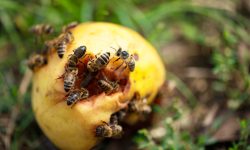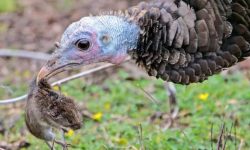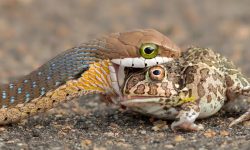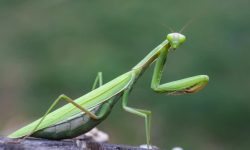Bearded dragons are among the most popular pet reptiles in the world — loved for their calm temperament, curious personalities, and easy care routines. But to keep your dragon healthy and happy, understanding its diet is essential. So, what do bearded dragons eat?
These reptiles are omnivores, meaning they eat both plants and animals. Their diet changes as they grow — younger dragons need more insects for protein, while adults thrive on a balance of vegetables, greens, and fruits. The right diet supports strong bones, bright colors, and an active lifestyle.
In this detailed guide, we’ll explore 20 foods bearded dragons love the most, including safe insects, nutritious vegetables, and fruits that keep them thriving. Whether you’re a new owner or an experienced reptile enthusiast, this guide will help you create a balanced, healthy diet plan for your dragon.
Understanding the Bearded Dragon Diet
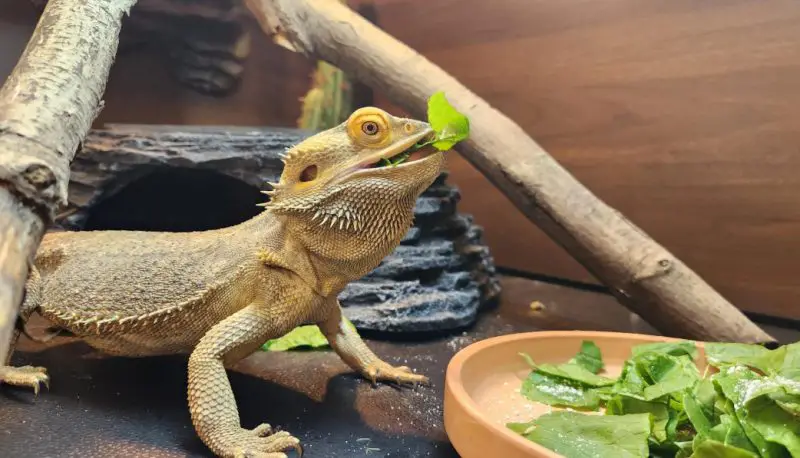
Omnivores with Changing Needs
Bearded dragons are opportunistic feeders, meaning they eat whatever’s available in their environment. In the wild, their diet includes insects, small animals, leaves, flowers, and fruits. In captivity, a balanced mix of protein, fiber, and vitamins is vital.
Young bearded dragons (under 12 months) need about 70% insects and 30% plant matter, while adults shift to about 70% vegetables and greens with only 30% insects. This change helps maintain healthy digestion and prevents obesity.
The Importance of Variety
Offering a diverse diet helps prevent nutritional deficiencies. A mix of greens, vegetables, fruits, and live insects provides the full range of nutrients — including calcium for bone strength and beta-carotene for vibrant colors.
Rotating foods also keeps your dragon interested and engaged during feeding time, which promotes natural foraging behavior.
Feeding Frequency and Hydration
Juvenile dragons eat 2–3 times daily, while adults usually eat once a day. Always provide fresh water, as hydration is key for digestion and shedding. Mist their greens or offer small soaks to encourage drinking.
20 Foods Bearded Dragons Love the Most
1. Crickets
Crickets are one of the most essential staple foods for bearded dragons, especially for hatchlings and juveniles. They’re high in protein and provide an excellent source of energy for rapid growth. Because they move quickly, crickets also help stimulate a dragon’s natural hunting instincts, providing both nutrition and mental enrichment.
Before feeding, always gut-load crickets with fresh vegetables and grains 24 hours in advance. This ensures they deliver additional vitamins and minerals to your dragon. To prevent calcium deficiency, dust them with calcium and vitamin D3 powder several times a week.
Avoid leaving live crickets in the enclosure overnight — they can bite your dragon or cause unnecessary stress. Feed only as many as your pet can eat within 10–15 minutes.
2. Dubia Roaches
Dubia roaches are a top-tier feeder insect and often preferred over crickets for their superior nutritional balance. They contain higher protein levels, more calcium, and less chitin, making them easier to digest.
Because they don’t jump, climb smooth surfaces, or smell, Dubia roaches are perfect for indoor reptile setups. They also reproduce easily, allowing owners to maintain a sustainable feeder colony at home.
Feed Dubia roaches 3–4 times per week as a primary insect source. Like crickets, gut-load them with fresh greens and grains for best results. Dragons usually love their movement and texture, making feeding time exciting.
3. Mealworms
Mealworms are popular among bearded dragons but should be used primarily as treats, not daily food. Their hard exoskeleton contains chitin, which can cause digestive blockages in young dragons.
They do, however, offer a rich source of fat and protein, making them excellent for underweight dragons or occasional energy boosts. Many dragons enjoy their wriggling motion, which triggers their natural hunting reflexes.
Offer mealworms once or twice a week, ideally after a meal of greens or as a reward. Avoid using them as the main food for juveniles.
4. Superworms
Superworms are a larger, softer, and more nutritious version of mealworms, ideal for adult bearded dragons. Their fat and moisture content make them highly palatable and satisfying.
They’re a great supplement for building muscle and encouraging natural foraging behavior. The active wriggling of superworms makes them irresistible to most dragons.
However, due to their higher fat content, limit feedings to 2–3 times a week. For safety, crush the head of live superworms before feeding to smaller dragons, as they can bite.
5. Waxworms
Waxworms are like candy for bearded dragons — soft, juicy, and delicious, but high in fat and low in protein. They’re perfect as an occasional treat or for dragons that have lost their appetite.
They can be particularly helpful during recovery or breeding periods when extra calories are beneficial. Their natural sweetness often tempts even the pickiest eaters.
Feed waxworms sparingly — about 2–3 worms once or twice a week is plenty. Overfeeding can lead to obesity and digestive imbalance.
6. Silkworms
Silkworms are among the healthiest live feeders for bearded dragons. They’re packed with calcium, protein, and essential amino acids while being low in fat.
Because of their smooth, soft bodies, silkworms are easy to digest, even for baby dragons. Their natural moisture content also supports hydration, which is especially important in dry environments.
Silkworms can be offered several times a week as a staple insect. They make an excellent alternative to crickets and Dubia roaches.
7. Hornworms
Hornworms are large, vibrant green caterpillars that dragons adore. They’re rich in water and essential nutrients, making them great for hydration and digestion.
Because they grow very quickly, a few hornworms can provide a filling meal for adult dragons. Their bright color and soft texture make them highly stimulating prey.
Feed hornworms occasionally (once or twice weekly) as part of a varied diet. Overfeeding may cause loose stools due to their high moisture content.
8. Collard Greens
Collard greens are one of the best daily vegetables for bearded dragons. They’re high in calcium, fiber, and vitamins A, C, and K — all crucial for bone and immune health.
Their thick, leafy texture promotes chewing, which strengthens jaw muscles and aids digestion. Collard greens are also low in oxalates, which means they don’t interfere with calcium absorption.
Serve them fresh, finely chopped, and mixed with other greens for a balanced meal. Avoid cooked greens, as cooking can reduce nutrient content.
9. Mustard Greens
Mustard greens are another powerhouse leafy vegetable packed with calcium, magnesium, and antioxidants. Their slightly peppery taste keeps dragons interested in their food.
They help support metabolic function and bone strength, making them a valuable daily staple. The high water content also aids hydration.
Rotate mustard greens with collards and turnip greens to keep meals diverse and prevent dietary boredom.
10. Dandelion Greens
Dandelion greens are an excellent, natural superfood for bearded dragons. They’re rich in calcium, iron, potassium, and vitamins A and K.
The leaves and flowers are both edible and promote strong bones and vibrant skin. These greens also support liver function and act as a gentle digestive aid.
Always ensure wild dandelions are pesticide-free. They can be fed daily, either alone or mixed into salads.
11. Turnip Greens
Turnip greens are highly nutritious, with one of the best calcium-to-phosphorus ratios among leafy vegetables. They’re also rich in vitamin C and fiber.
Their slightly bitter taste encourages appetite diversity, and when mixed with sweeter vegetables, they’re more appealing.
Feed turnip greens 2–3 times per week alongside other dark greens. Avoid feeding turnip roots, as they contain higher sugar content.
12. Squash
Squash varieties — such as butternut, acorn, and spaghetti squash — are excellent additions to a bearded dragon’s diet. They’re packed with fiber, vitamin A, and hydration.
Their soft texture makes them safe and easy to eat when shredded or grated. The natural sweetness also encourages dragons to eat more greens.
Squash can be served raw or lightly steamed and mixed into salads several times per week.
13. Carrots
Carrots are a colorful and nutritious vegetable full of beta-carotene, which enhances skin and scale pigmentation.
They also provide fiber for smooth digestion. However, because carrots are high in vitamin A, feed them in moderation to avoid excess accumulation.
Serve carrots shredded or finely chopped once or twice a week. Mixing them with greens improves both texture and appeal.
14. Bell Peppers
Bell peppers add color, flavor, and hydration to your dragon’s diet. They’re high in vitamin C and antioxidants that promote strong immunity.
Red, yellow, and orange peppers are the most nutrient-rich and sweet-tasting, making them favorites among dragons.
Feed chopped raw bell peppers 2–3 times weekly in small portions. Avoid hot peppers, as spicy varieties can irritate digestion.
15. Blueberries
Blueberries are a nutrient-dense treat loaded with antioxidants, vitamin C, and hydration. Their soft texture makes them easy to chew and digest.
They’re perfect for an occasional snack that supports immune health and hydration. The dark pigment in blueberries may even help improve scale color vibrancy.
Limit to 2–3 berries once or twice a week due to their natural sugar content. Always rinse before serving.
16. Strawberries
Strawberries are another sweet fruit favorite among dragons. They’re rich in water and vitamin C, helping boost hydration and resistance to illness.
The juicy, bright red flesh makes them irresistible to most dragons. Their texture also encourages chewing and natural foraging behavior.
Feed strawberries in moderation — about a few small pieces weekly. Too much sugar can upset their digestive balance.
17. Apples
Apples provide crunch, hydration, and natural sweetness that dragons enjoy. They’re a good source of fiber and vitamin C.
Always peel and remove the seeds before serving, as apple seeds contain trace toxins that can harm reptiles. Chop into bite-sized cubes for easy eating.
Feed apples as a treat once a week, not as a regular fruit. Mixing them with greens can make salads more appealing.
18. Cactus Pads (Prickly Pear)
Cactus pads, or nopales, are a natural desert food that mirrors what wild bearded dragons eat in their native Australian habitat.
They’re packed with calcium, fiber, and water, making them great for hydration and digestion. They also have anti-inflammatory properties that support internal health.
Remove all spines and dice the pads into small chunks before serving. Most dragons love their juicy, mild flavor.
19. Green Beans
Green beans are a crunchy, fibrous vegetable that adds variety and nutrients to your dragon’s diet. They’re rich in vitamins A, C, and K, along with essential minerals.
Their mild flavor complements other vegetables, making them easy to mix into salads. They also aid in digestion and hydration.
Serve raw or lightly steamed, chopped into small pieces, 2–3 times per week.
20. Sweet Potatoes
Sweet potatoes are a nutritious and filling food that provides beta-carotene, fiber, and complex carbohydrates. They support sustained energy and healthy digestion.
Cook and mash or grate them before feeding to improve texture and nutrient absorption. Avoid serving raw, as they can be tough to digest.
Feed sweet potatoes once or twice weekly as a nutritious, warming treat that complements leafy greens and insects.
Frequently Asked Questions (FAQs)
How often should I feed my bearded dragon?
Young dragons eat 2–3 times daily, while adults eat once a day. Always offer a mix of insects and vegetables according to age.
Can bearded dragons eat lettuce?
Avoid iceberg lettuce — it lacks nutrients and can cause diarrhea. Stick to darker greens like collard or mustard greens.
What fruits can bearded dragons eat safely?
Fruits like blueberries, strawberries, apples, and mangoes are safe in moderation. Limit to once or twice a week.
How do I give my dragon enough calcium?
Dust insects with calcium powder 4–5 times a week for juveniles and 2–3 times for adults to prevent metabolic bone disease.
Can bearded dragons eat human food?
Only specific natural foods are safe. Avoid processed foods, dairy, and high-sodium snacks — they can harm your dragon’s digestive system.
Conclusion
A balanced diet is the foundation of a healthy, happy bearded dragon. From protein-packed insects to leafy greens and colorful fruits, variety is the key to meeting their nutritional needs.
By offering safe, nutrient-rich foods, you’ll support strong bones, healthy skin, and vibrant energy levels. Understanding what your bearded dragon eats — and how much — ensures your reptile companion thrives in captivity just as it would in the wild.
So next time you prepare your dragon’s meal, remember: it’s not just feeding time — it’s an opportunity to nurture a creature that depends on you for health, strength, and longevity.

